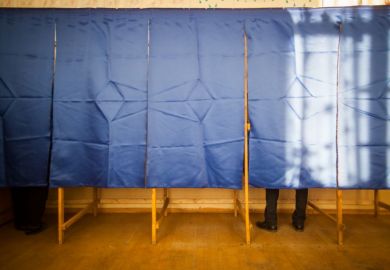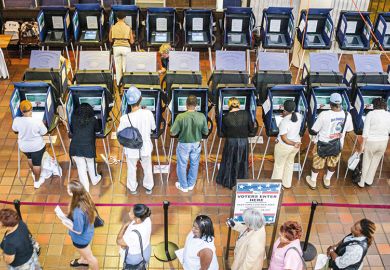US college students could prove to be a deciding factor in key election races across the nation next month, but record high turnout seen in recent years could be dented by new restrictions on campus voting and the absence of the “Trump factor”.
The 8 November midterm vote – a congressional-year election without a presidential race – comes with Democrats in narrow control of both chambers of the US Congress and widely expected to lose seats and at least one of their majorities.
Party strategists hoping to rescue their fortunes have focused heavily on campuses after nearly 40 per cent of eligible college students cast votes in the 2018 midterms, more than double the 19 per cent level of 2014. Student voting also hit a record 66 per cent in the 2020 presidential-year election.
Some believe that student turnout could be further boosted by continuing growth in voter registration and education campaigns promoted by universities, and by recent US Supreme Court actions including the revocation of the half-century-old federal guarantee of the right to an abortion.
Developments countering these hopes, however, include the absence on the ballot of Donald Trump to serve as ideological motivator for students; the distance in time from the energy of the George Floyd protests; and a heavy campaign of pushback in some Republican-led states that will make voting more difficult, including imposing new registration and voting requirements, and restricting polling locations, times and methods.
The sharp rise in student voting in recent years is the result of hard work by many people inside higher education and beyond over an extended period of time, said Nancy Thomas, the director of the Institute for Democracy & Higher Education at Tufts University, a leading collector of data on college student voting. Yet it has also been driven in large part by the Trump phenomenon, Dr Thomas acknowledged. “Are these exponential increases a trend or are they a blip?” she said. “We don't know right now.”
“It really is balanced on the edge right now,” agreed Michael Burns, the national director of the Campus Vote Project, at the Fair Elections Center, a national non-partisan voting rights and election reform organisation.
But others are more optimistic. University leaders have been getting increasingly involved in helping their students vote, and students are showing up in unprecedented numbers at voter education and registration activities, said Clarissa Unger, co-founder and executive director of the Students Learn Students Vote Coalition, which has a goal of 50 per cent college student turnout for this year’s midterm election.
“There are a lot of positive indicators” across the country, said Jen Domagal-Goldman, executive director of the ALL IN Campus Democracy Challenge, a project of the Civic Nation advocacy organisation. “We’re excited and we’re hopeful.”
Yet she and the others admit concern in areas that include Republican officials shutting polling stations near campuses, drawing electoral district boundary lines that dilute the voting power of students and imposing tough new voter identification requirements. One high-profile example is Texas A&M University, where local officials have announced plans to shut down an early-voting site that had existed on campus, citing staffing shortages.
Mr Burns said the problem could be solved with more effort to hire poll workers – including students themselves. The Biden administration tried to help, Dr Thomas said, by ruling that universities could use their federal job funds known as work-study to employ students in voter-related activities. Republican states pushed back, she said, by imposing new worker training requirements and threatening legal repercussions for those who did not comply with them, even in such areas as staffing registration tables in hallways.
Register to continue
Why register?
- Registration is free and only takes a moment
- Once registered, you can read 3 articles a month
- Sign up for our newsletter
Subscribe
Or subscribe for unlimited access to:
- Unlimited access to news, views, insights & reviews
- Digital editions
- Digital access to THE’s university and college rankings analysis
Already registered or a current subscriber?









